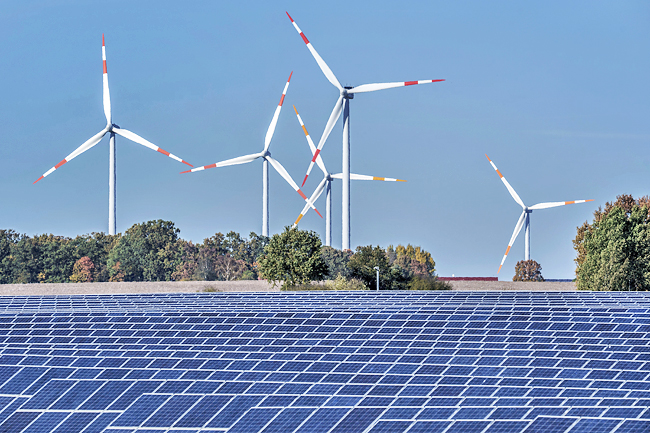In Short : Expanding clean energy sources on the electric grid is crucial for reducing greenhouse gas emissions and combating climate change. Transitioning from fossil fuels to renewable energy like solar, wind, and hydroelectric power can significantly decrease carbon emissions and promote a more sustainable future.
In Detail : Investing in America’s Electric Grid Means Deploying More Clean Energy and Saving Consumers Money
The electric grid is an often the unsung hero in daily our lives – bringing power from where it is generated to homes and businesses, allowing us to power our appliances and phones, ensuring we can heat or cool our spaces to remain comfortable, and keeping the lights when we need them. Having a secure, reliable, and resilient electric grid also is essential to the success of clean energy like solar and wind because in many cases, where this power is generated is often not where it is immediately used. This is especially important for meeting clean energy goals and increasing demand for electrified homes, businesses, and vehicles.
The Department of Energy (DOE) is making critical investments in the nation’s electric grid to lower the cost of energy, all while enabling cleaner energy sources, less pollution, and an easier time installing solar panels or plugging in an electric vehicle at home. In the largest grid investments in history, on October 18, 2023, DOE announced up to $3.46 billion for 58 projects across 44 states to strengthen electric grid resilience and reliability across the United States, all while improving climate resilience and creating good-paying union jobs. These projects will leverage more than $8 billion in federal and private investments as part of the Grid Resilience and Innovation Partnerships (GRIP) Program, funded through the Bipartisan Infrastructure Law and administered by DOE’s Grid Deployment Office (GDO). Across the selected projects, there are various strategies to increase the integration of renewables, in total allowing more than 35 gigawatts of renewable energy to be brought online and expand the country’s renewable energy capacity by 10.5%. The projects also will enhance grid flexibility, meaning that operators can balance different types of power in real time and in response to real conditions to help keep the power on and prices affordable.
In Delaware, Pecan Street Inc. will accelerate the state’s clean energy transition by meeting customer demand to install rooftop solar. It will do so by eliminating seasonal solar congestion, a primary barrier that currently prevents approval of new residential and small commercial solar interconnection requests. Anticipated outcomes include new solar arrays for 1,500 homes in project service areas, including 150 within disadvantaged communities.
In Florida, the City of Lake Worth Beach (LWB) will deploy targeted improvements to transform the community’s electric grid, including adding an estimated 7 megawatts of solar capacity and enabling the city to retire a 35 megawatts fossil fuel power plant adjacent to the LWB Community High School to help reduce environmental exposure and burdens.
In Illinois, the City of Naperville and its municipally owned utility, Naperville Electric Utility, will deploy advanced software and hardware to accelerate the growth of new generation, storage, and electrification assets being added to the grid to support the state’s transition to 100% clean, renewable energy by 2050. Efforts are expected to indirectly decrease energy costs for consumers and decrease environmental pollution with growing integration of clean, renewable resources.
Across the Midwest, the Joint Targeted Interconnection Queue (JTIQ) Transmission Study Process and Portfolio will coordinate the comprehensive planning, design, and construction of five transmission projects spanning seven Midwest states (Iowa, Kansas, Nebraska, North Dakota, Minnesota, Missouri, and South Dakota). This coordinated, long-range, interregional project that accelerates interconnections to unlock approximately 30 gigawatts of new generation, primarily wind and solar energy.
In Oregon, the Confederated Tribes of Warm Springs Reservation of Oregon and Portland General Electric (PGE) will upgrade transmission capacity along an existing path to connect PGE customers with the currently isolated renewable resources east of the Cascade Mountains, including those on the Warm Springs Reservation—building a bridge to up to 1,800 megawatts of carbon-free solar resources.
In Pennsylvania, GRIP funding for Duquesne Light Company will enhance system capacity to unlock clean energy generation and meet targets established in the city of Pittsburgh’s Climate Action Plan while also reducing energy bills, increasing high-quality job opportunities and training, and boosting parity in clean energy access and adoption.
These are just a few examples of GRIP projects that will not only leverage existing grid technologies, but also demonstrate the effectiveness of state-of-the art technologies and innovative strategies to allow more renewable energy sources to be brought online, laying the groundwork for implementation in other parts of the country. By expanding capacity and improving flexibility, the addition of new clean energy resources, like solar and wind, will be vital in keeping the power on and building a sustainable clean energy future for present and future generations.

